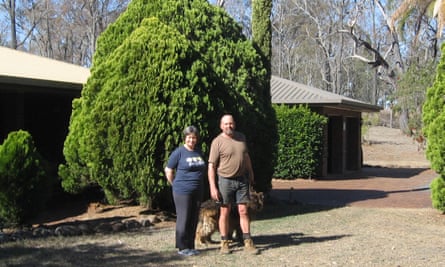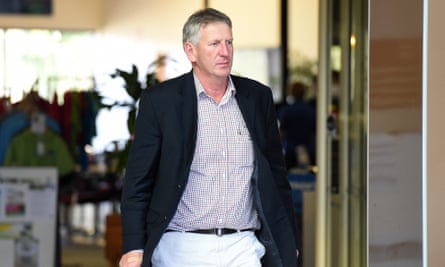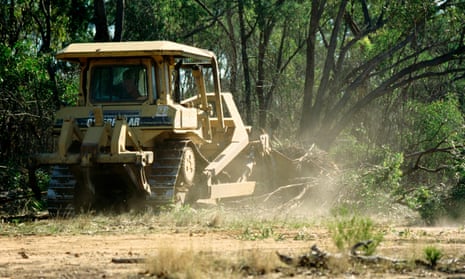A wealthy Queensland family lobbied high-ranking government officials to reroute Australia’s multibillion-dollar inland rail project past their privately owned airport, documents reveal.
The government originally announced its preferred route for the $10bn Brisbane-to-Melbourne freight rail line in 2010, following an exhaustive investigation that chose from more than 50,000 options.
But significant changes were announced last year to a section running through Queensland’s Darling Downs region, a decision that has infuriated farmers and landowners who suddenly found themselves in the railway’s path.
The new route diverted the line past the recently built Wellcamp airport, near Toowoomba, which carries a single weekly freight flight to Hong Kong, and some domestic passenger and freight services.
The airport is owned by the Wagners, a prominent Queensland family whose business empire helped them climb to 14th on the BRW rich families list in 2015.
Documents obtained under freedom of information laws reveal the Wagners mounted a significant lobbying effort the year before the decision was announced.
An email trail shows John Wagner wrote directly to the then secretary of the infrastructure department Mike Mrdak in late July 2016, with a short pitch in favour of diverting the rail line.
“Hi Mike. How are things going in your world?” it began.
“[Name redacted] thought it would take about 3 weeks to relook at a diversion via Wellcamp if he was given the go ahead to have a look at it,” he said. “We would welcome the opportunity to come down and talk to you and Minister [Darren] Chester at a time that was convenient.”
Mrdak replied on the same day, saying “we would be very pleased to discuss”.
About a week later, on 7 August, another member of the Wagner family, Denis Wagner, wrote to the infrastructure department secretary, saying: “I caught up with [named redacted] and [name redacted] last Friday to discuss the alignment for the rail.
“I think we are all clear that our interest is to have the alignment run past the Wellcamp airport, regardless which route is ultimately accepted as the best route overall.”
He ended his email by asking: “Is there anything further we can do to assist with progressing the investigation of a route past the Wellcamp airport?”
About a month later, the department wrote to Chester, the then transport minister, asking him to sign off on a new study investigating diverting the inland rail past the Wagners’ airport.
Internal briefing papers dated August 2016 reveal the Wagners also offered to help the government pay for the new study, and build a new freight facility “to be opened when the line was completed”.
“The Wellcamp owners have informally raised the possibility of a contribution to the study,” the department’s internal briefings say. “We do not support this as it would lose the report’s independence; however, we should stay open to seeking a contribution to any capital costs should a change in the alignment be realised.”

The Wagners did not end up paying for the study, nor did they make capital contributions.
An independent study was eventually approved to consider four options, including the route past Wellcamp.
Guardian Australia is not suggesting the Wagners acted illegally or improperly in any way, or that their lobbying was the sole reason for diverting the rail line. Other parties were also lobbying for the route to be diverted to the airport, including before the Wagners’ emails.
The infrastructure department said any suggestion that outside influence shaped the decision was “false”, and that the chosen route was the fastest of the four options considered in the independent study, and the cheapest of all but the original 2010 base case.
“The inference that there was any outside influence on the selection of the preferred study corridor for the Yelarbon to Gowrie inland rail section is false,” a spokesperson said.
“The decision to review the study corridor was based on a number of factors including the recent development of the Toowoomba industrial precinct and stakeholder and community feedback from local, state and federal representatives.”
Denis Wagner said his family was far from the only private interest lobbying on the route of the inland rail, and that the original 2010 alignment was always intended to be subject to change.
“We did, as did several other parties, lobby the Federal Government when the decision was made to progress the project,” Wagner told Guardian Australia. “We asked them to consider what we thought to be an important aspect of the future use of Inland Rail, which was the interface between the rail and the Wellcamp airport. Whilst at that time there was a single scheduled freight flight per week, it is our view the number of flights will significantly increase in future.”
Guardian Australia has reported extensively on fundamental flaws in Australia’s lobbying rules, which keep some attempts to influence government hidden from public view. The Wagners’ lobbying, and that of other parties, was not visible because the family approached the government directly, rather than engaging registered lobbyists to act on their behalf.
Quick GuidePolitical lobbying in Australia: the basics
Show
What do lobbyists do?
Lobbyists attempt to influence government policy or decisions on behalf of either a client or their own organisation. Ethical lobbying is a valuable and important element of a healthy democracy. It helps those who have a stake in government policy to convey their views and expertise. There are two broad types of lobbyists: third-party lobbyists, who are engaged as consultants; in-house lobbyists, who work directly for corporations or interest groups.
Who hires lobbyists?
For many Australians, lobbying conjures images of powerful corporations working to sway politicians behind the scenes. There is a truth in that. The big banks, mining and energy giants, pharmaceutical companies, casinos, Amazon, Google and Facebook all engage lobbyists. But lobbyists also work on behalf of not-for-profits and community groups, including for veterans, social workers, aged-care staff, school principals and environmental organisations.
What is the lobbyist register?
The lobbyist register is the public's only window into the world of lobbying. It's a publicly available online list of lobbying firms, individual lobbyists and their clients. The register was a huge step forward when it was introduced in 2008, but remains frustratingly opaque. It doesn't tell us who is lobbying whom, about what, or when. Compare that with the ACT, where lobbyists are required to file quarterly reports on their activities, or NSW, where ministers are required to publish their diaries. The federal register is also completely blind to the activities of in-house lobbyists.
What is the lobbyist code of conduct?
The code tells lobbyists how they must behave when approaching the government and is designed to maintain ethical standards. But the code is not legislated and has no real teeth. It goes largely unenforced and the punishments are weak. The worst sanction available to authorities is removing a lobbyist from the register. The US and Canada have fines or jail terms for law breaches.
Who keeps an eye on lobbyists?
Federally it's the prime minister's department that loosely oversees lobbying. It takes on a largely administrative role, rather than an investigative or regulatory one. Its core job is to maintain the register and communicate the code's requirements to lobbyists. It lacks independence, relies on reports of bad lobbying and rarely, if ever, takes enforcement action.
The diversion to the airport cuts a new path across the Condamine floodplain, the site of major floods in 2010.
Multiple landowners told Guardian Australia they felt ignored during the process, and labelled the consultation “farcical”.
Local Ross Berghofer, like many, will have his 330-hectare property cut in two by the new line. The railway was originally slated to be built across the road from his place. Now, he says, his land will be rendered worthless.
“[It will go] straight through the middle. Pretty well over all the irrigation infrastructure, the underground mains, the underground pipes, hydrants, mains, your irrigation. The lot,” he said.
“It’s going to totally destroy it. It’s just going to be unviable.
“Half of it will be completely landlocked, you won’t even be able to get to it. The neighbours are going to love me.”
The main argument for connecting Wellcamp airport with the inland rail is that it will link up air and rail freight, and bring benefits if passenger trains ever begin operating. The airport did not exist at the time of the original 2010 study, and the Wagners said connecting it with the inland rail would open up “much of central Victoria, regional New South Wales and southern Queensland to exports for perishable and time-sensitive freight into the Asian regions”.
But Wellcamp still operates only a single weekly airfreight service to Hong Kong, and the department’s own advice to the then minister Chester suggested rail and air freight were usually different.
“We note that air freight would not typically use rail,” the department’s advice said.
Denis Wagner told Guardian Australia there was no reason “why freight cannot be railed then air freighted” and said he expects more international freight services from Wellcamp in time.
“There is absolutely no reason as to why produce cannot use rail to access the air service from Wellcamp into Asia and beyond,” he said.
Paul and Karen Clapham have lived on their property at Southbrook, on the Gore Highway, for 14 years. The new route of the inland rail will cut across their front garden and along the back of their property. They say their home will be left “unliveable”.
“This was to be our forever home,” the couple told Guardian Australia in a statement. “We will be approaching retirement age in the not too distant future and do not want the upheaval and stress of packing up our home and animals, to start again somewhere else.”
The Claphams say they were first told about the decision in October last year. The emails between the Wagners and government officials began in at least July 2016, according to internal documents.
Tim Durre, another local landholder, said his property would be cut into two triangles by the rail line. One would be near-inaccessible and the other would not be able to be watered, he said.

“The block is useless if you can’t water,” he told Guardian Australia. “It’s just not right.”
“I’m not being a whinger. We’re just not getting a fair go, enough’s enough.”
The Wagners and the department have denied any suggestion that proper consultation with landowners did not take place. Denis Wagner said the rail line was always going to frustrate landowners, no matter which way it went.
“Whichever route was chosen, whether it be across the Condamine floodplain or somewhere else, it would create concern by different landowners,” he said.
Kev Loveday, a local farmer, owns two pieces of land on the Condamine. The current rail route will cut through a corner of one of them.
“It’s proposed to go right through the corner of my place where my irrigation and stock bore is situated,” Loveday said. “It’s just the one bore. If it goes straight across the top of that, it will severely affect my ability to run cattle out there.”
Many local farmers are warning of the significant risk of flooding on the Condamine floodplains. The area was hit hard by floods in 2010, and locals say the soil type and heavy summer rains can prove dangerous.
“The rain falls mainly in summer, and it can fall viciously,” Loveday said. “So rather than a steady increase in water volume through a river… these floods are very quick.”
The ARTC is prioritising an engineering solution to get the rail safely across the floodplain.
